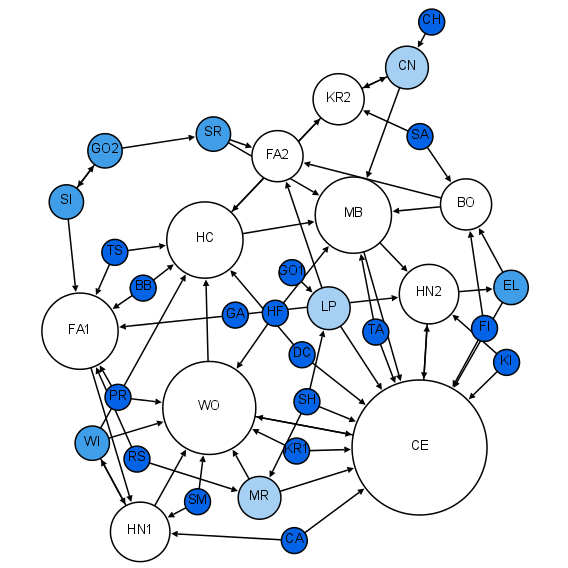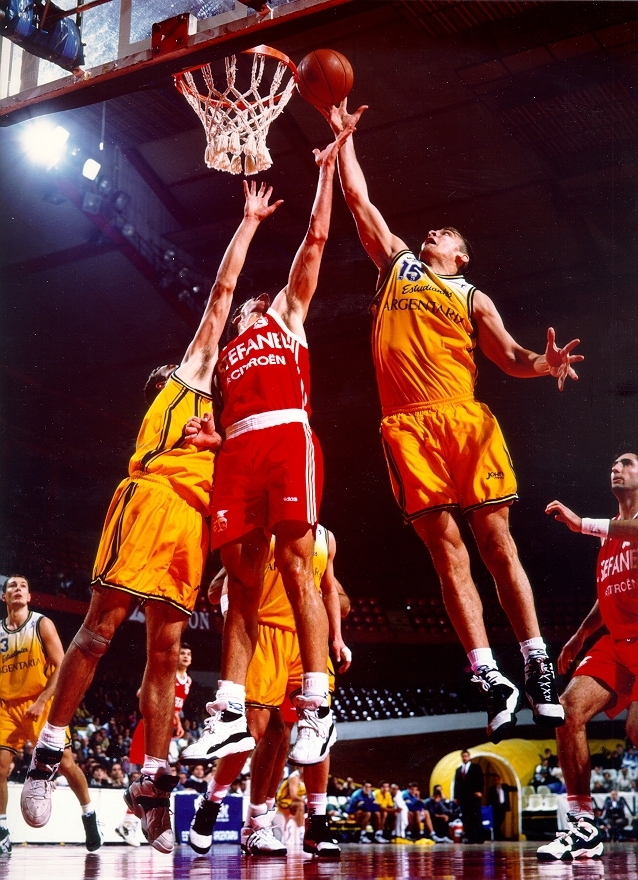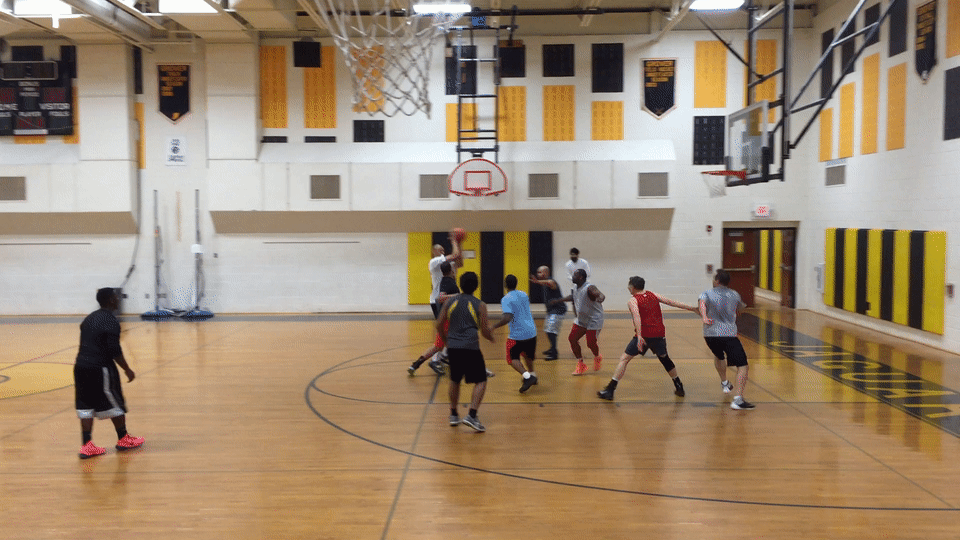|
Network Science Based Basketball Analytics
Network Science based basketball analytics comprise a various recent attempts to apply the perspective of networks to the analysis of basketball. Overview Traditional basketball statistics analyze individuals independently of their teammates or competitors and traditional player positions are determined by individual attributes. In contrast, these network based analytics are obtained by constructing a team or league level player networks, where individual players are nodes connected by the ball movement or by some measure of similarity. Then the metrics are obtained by calculating network properties, such as degree, density, centrality, clustering, distance etc. This approach enriches the analysis of basketball with new individual and team level statistics and offers a new way of assigning position to a player. Team level statistics The biggest contribution to the team level metrics came from Arizona State University researchers led by Jennifer H. Fewell. Using 2010 NBA first r ... [...More Info...] [...Related Items...] OR: [Wikipedia] [Google] [Baidu] |
Network Science
Network science is an academic field which studies complex networks such as telecommunication networks, computer networks, biological networks, cognitive and semantic networks, and social networks, considering distinct elements or actors represented by ''nodes'' (or ''vertices'') and the connections between the elements or actors as ''links'' (or ''edges''). The field draws on theories and methods including graph theory from mathematics, statistical mechanics from physics, data mining and information visualization from computer science, inferential modeling from statistics, and social structure from sociology. The United States National Research Council defines network science as "the study of network representations of physical, biological, and social phenomena leading to predictive models of these phenomena." Background and history The study of networks has emerged in diverse disciplines as a means of analyzing complex relational data. The earliest known paper in this f ... [...More Info...] [...Related Items...] OR: [Wikipedia] [Google] [Baidu] |
Bootstrapping (statistics)
Bootstrapping is any test or metric that uses random sampling with replacement (e.g. mimicking the sampling process), and falls under the broader class of resampling methods. Bootstrapping assigns measures of accuracy (bias, variance, confidence intervals, prediction error, etc.) to sample estimates.software This technique allows estimation of the sampling distribution of almost any statistic using random sampling methods. Bootstrapping estimates the properties of an (such as its ) by measuring those properties when sampling from an approximating distribution. One standard choice for an a ... [...More Info...] [...Related Items...] OR: [Wikipedia] [Google] [Baidu] |
APBRmetrics
Advanced statistics (also known as analytics or APBRmetrics) in basketball refers to analyzing basketball statistics through objective evidence. APBRmetrics is a cousin to the study of baseball statistics, known as sabermetrics, and similarly takes its name from the acronym APBR, which stands for the Association for Professional Basketball Research. A key tenet for many modern basketball analysts is that basketball is best evaluated at the level of possessions. During a single game, both teams have approximately the same number of possessions, because they alternate possession. (A team can have slightly more if it begins and ends a quarter or half with possession.) However, over the course of the season, teams play at very different paces, which can dramatically color their points scored and points allowed per game. Therefore, these analysts favor use of points scored per 100 possessions (offensive rating) and points allowed per 100 possessions (defensive rating). A second core t ... [...More Info...] [...Related Items...] OR: [Wikipedia] [Google] [Baidu] |
Graph Theory
In mathematics, graph theory is the study of ''graphs'', which are mathematical structures used to model pairwise relations between objects. A graph in this context is made up of '' vertices'' (also called ''nodes'' or ''points'') which are connected by '' edges'' (also called ''links'' or ''lines''). A distinction is made between undirected graphs, where edges link two vertices symmetrically, and directed graphs, where edges link two vertices asymmetrically. Graphs are one of the principal objects of study in discrete mathematics. Definitions Definitions in graph theory vary. The following are some of the more basic ways of defining graphs and related mathematical structures. Graph In one restricted but very common sense of the term, a graph is an ordered pair G=(V,E) comprising: * V, a set of vertices (also called nodes or points); * E \subseteq \, a set of edges (also called links or lines), which are unordered pairs of vertices (that is, an edge is associated with t ... [...More Info...] [...Related Items...] OR: [Wikipedia] [Google] [Baidu] |
Network Science
Network science is an academic field which studies complex networks such as telecommunication networks, computer networks, biological networks, cognitive and semantic networks, and social networks, considering distinct elements or actors represented by ''nodes'' (or ''vertices'') and the connections between the elements or actors as ''links'' (or ''edges''). The field draws on theories and methods including graph theory from mathematics, statistical mechanics from physics, data mining and information visualization from computer science, inferential modeling from statistics, and social structure from sociology. The United States National Research Council defines network science as "the study of network representations of physical, biological, and social phenomena leading to predictive models of these phenomena." Background and history The study of networks has emerged in diverse disciplines as a means of analyzing complex relational data. The earliest known paper in this f ... [...More Info...] [...Related Items...] OR: [Wikipedia] [Google] [Baidu] |
Three-point Field Goal
A three-point field goal (also 3-pointer, three, or trey) is a field goal in a basketball game made from beyond the three-point line, a designated arc surrounding the basket. A successful attempt is worth three points, in contrast to the two points awarded for field goals made within the three-point line and the one point for each made free throw. The distance from the basket to the three-point line varies by competition level: in the National Basketball Association (NBA) the arc is from the center of the basket; in the International Basketball Federation (FIBA), the Women's National Basketball Association (WNBA), the National Collegiate Athletic Association (NCAA) (all divisions), and the National Association of Intercollegiate Athletics (NAIA), the arc is from the center of the basket; and in the National Federation of State High School Associations (NFHS) the arc is from the center of the basket. Every three-point line becomes parallel to each sideline at the points where e ... [...More Info...] [...Related Items...] OR: [Wikipedia] [Google] [Baidu] |
Rebound (basketball)
In basketball, a rebound, sometimes colloquially referred to as a board, is a statistic awarded to a player who retrieves the ball after a missed field goal or free throw. Rebounds in basketball are a routine part in the game; if a shot is successfully made possession of the ball will change, otherwise the rebound allows the defensive team to take possession. Rebounds are also given to a player who tips in a missed shot on his team's offensive end. A rebound can be grabbed by either an offensive player or a defensive player. Rebounds are divided into two main categories: "offensive rebounds", in which the ball is recovered by the offensive side and does not change possession, and "defensive rebounds", in which the defending team gains possession. The majority of rebounds are defensive because the team on defense tends to be in better position (i.e., closer to the basket) to recover missed shots. Offensive rebounds give the offensive team another opportunity to score whether r ... [...More Info...] [...Related Items...] OR: [Wikipedia] [Google] [Baidu] |
Assist (basketball)
In basketball, an assist is attributed to a player who passes the ball to a teammate in a way that leads directly to a score by field goal, meaning that they were "assisting" in the basket. An assist is also credited when a basket is awarded due to defensive goaltending. There is some judgment involved in deciding whether a passer should be credited with an assist. An assist can be scored for the passer even if the player who receives the pass makes a basket after dribbling the ball for a short distance. However, the original definition of an assist did not include such situations,Hal BockGive an assist to NBA, ''The Milwaukee Journal Sentinel'', April 28, 2002. so the comparison of assist statistics across eras is a complex matter. Only the pass directly before the score may be counted as an assist, so no more than one assist can be recorded per field goal (unlike in other sports, such as ice hockey). A pass that leads to a shooting foul and scoring by free throws does not cou ... [...More Info...] [...Related Items...] OR: [Wikipedia] [Google] [Baidu] |
Block (basketball)
In basketball, a block or blocked shot occurs when a defensive player legally deflects a field goal attempt from an offensive player to prevent a score. The defender is not allowed to make contact with the offensive player's hand (unless the defender is also in contact with the ball) or a '' foul'' is called. In order to be legal, the block must occur while the shot is traveling upward or at its apex. A deflected field goal that is made does not count as a blocked shot and simply counts as a successful field goal attempt for shooter plus the points awarded to the shooting team. For the shooter, a blocked shot is counted as a missed field goal attempt. Also, on a shooting foul, a blocked shot cannot be awarded or counted, even if the player who deflected the field goal attempt is different from the player who committed the foul. If the ball is heading downward when the defender hits it, it is ruled as goaltending and counts as a made basket. Goaltending is also called if the block ... [...More Info...] [...Related Items...] OR: [Wikipedia] [Google] [Baidu] |
Steal (basketball)
In basketball, a steal occurs when a defensive player legally causes a turnover by their positive, aggressive action(s). This can be done by deflecting and controlling, or by catching the opponent's pass or dribble of an offensive player. The defender must not touch the offensive player's hands or otherwise a foul is called. Steals are credited to the defensive player who first causes the turnover, even if they do not end up with possession of the live ball. To earn a steal, the defensive player must be the initiator of the action causing the turnover, not just the benefactor. Whenever a steal is recorded by a defensive player, an offensive player must be credited as committing a turnover. Stealing the ball requires good anticipation, speed and fast reflexes, all common traits of good defenders. However, like blocked shots, steals are not always a perfect gauge of a player's defensive abilities. An unsuccessful steal can result in the defender being out of position and unable ... [...More Info...] [...Related Items...] OR: [Wikipedia] [Google] [Baidu] |
Point (basketball)
Points in basketball are used to keep track of the score in a game. Points can be accumulated by making field goals (two or three points) or free throws (one point). If a player makes a field goal from within the three-point line, the player scores two points. If the player makes a field goal from beyond the three-point line, the player scores three points. The team that has recorded the most points at the end of a game is declared that game's winner. NBA Regular season * Most career points: Kareem Abdul-Jabbar (38,387 pts) * Highest career scoring average: Michael Jordan (30.12 ppg) * Most points scored in a season: 4,029 by Wilt Chamberlain (1961–62) * Highest seasonal scoring average: 50.4 by Wilt Chamberlain (1961–62) * Most points in one game: 100 by Wilt Chamberlain (3/2/1962 vs. New York Knicks) * Most points in one half, regular season: 59 by Wilt Chamberlain * Most points in one quarter, regular season: 37 by Klay Thompson * Most points in one overtime period, ... [...More Info...] [...Related Items...] OR: [Wikipedia] [Google] [Baidu] |
Muthu Alagappan
Muthu Alagappan (born ) was a medical resident who is known for his professional basketball analytics. He was born in England and raised in Texas. During college at Stanford University, he began an internship at big data startup company Ayasdi, where he leveraged their software on basketball statistics to determine 13 distinct positions of play. After he spoke at the 2012 MIT Sloan Sports Analytics Conference, several professional teams began to use the company's software. He was given the top prize at the conference, and '' GQ'' called his work both "a new frontier for the NBA" and "Muthuball"—an allusion to Moneyball baseball statistical analysis known for revolutionizing the sport. ''Forbes'' included him in their 2012 and 2013 " 30 Under 30" list of influential people in the sports industry. His work has received mention in ''The New York Times'', ESPN, ''The Wall Street Journal'', ''Wired'', and ''Slate''. Early life Alagappan was born in Crewe, England and raised i ... [...More Info...] [...Related Items...] OR: [Wikipedia] [Google] [Baidu] |

.jpg)


.jpg)